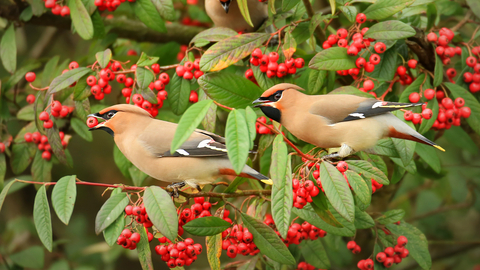
©Jon Hawkins Surrey Hills Photography
Waxwing
Species information
Statistics
Length: 18cmWingspan: 34cm
Weight: 63g
Conservation status
When to see
October to MarchAbout
A starling-sized bird, the waxwing is one of the UK's most exotic-looking birds, with a large, orangey-pink crest. It does not breed in the UK, but is a winter visitor from Northern Europe and can be spotted in flocks on bushes full of berries - it isn't fussy where the bushes are and frequents towns, car parks and gardens. Waxwings prefer rowan and hawthorn berries, but can be enticed with hung-up apples. Sudden invasions of large numbers of waxwings (called 'irruptions') occur when the berry crops fail in Northern Europe.How to identify
The waxwing has a pink crest and breast, a black mask and throat, a grey rump, a black tail that is tipped with bright yellow, and yellow-and-white markings on its wings.In our area
Waxwings are one of the most exotic-looking birds to visit the UK. If winter conditions are particularly bad on mainland Europe, many thousands of them will flock to the UK, where they will fly around in groups to find food. They sometimes only stop on the east coast and venture a few miles inland, but during a "waxwing year", many continue to travel further west and occasionally stop off in Shropshire during December and January if berries are in short supply elsewhere.
Good places to look out for them in the county include retail parks in Shrewsbury, Telford and Newport, where berry-bearing trees are often planted around the perimeter. But they could show up anywhere with lots of berry trees, including parks and gardens.
Reported sightings are recorded by Shropshire Ornithological Society on their webpage here.
Distribution
A rare winter visitor which can turn up anywhere, particularly in the north and east of the country.Habitats
Did you know?
Waxwings tend to prefer eating red berries to orange berries; but they will choose the latter over yellow and white ones. This pattern is seen in many other berry-eating birds. One downside of eating so many berries is that the birds sometimes become a bit intoxicated by fermenting fruit.Watch
Waxwings by Jack Perks

